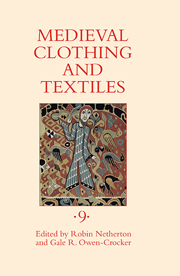Book contents
- Frontmatter
- Contents
- Illustrations
- Tables
- Contributors
- Preface
- 1 Bridal Gifts in Medieval Bari
- 2 The Marriage of the Year (1028)
- 3 Clothing as Currency in Pre-Norman Ireland?
- 4 Cistercian Clothing and Its Production at Beaulieu Abbey, 1269–70
- 5 Clothing and Textile Materials in Medieval Sweden and Norway
- 6 The Iconography of Dagged Clothing and Its Reception by Moralist Writers
- 7 Domestic Painted Cloths in Sixteenth-Century England: Imagery, Placement, and Ownership
- Recent Books of Interest
- Contents of Previous Volumes
2 - The Marriage of the Year (1028)
Published online by Cambridge University Press: 05 July 2013
- Frontmatter
- Contents
- Illustrations
- Tables
- Contributors
- Preface
- 1 Bridal Gifts in Medieval Bari
- 2 The Marriage of the Year (1028)
- 3 Clothing as Currency in Pre-Norman Ireland?
- 4 Cistercian Clothing and Its Production at Beaulieu Abbey, 1269–70
- 5 Clothing and Textile Materials in Medieval Sweden and Norway
- 6 The Iconography of Dagged Clothing and Its Reception by Moralist Writers
- 7 Domestic Painted Cloths in Sixteenth-Century England: Imagery, Placement, and Ownership
- Recent Books of Interest
- Contents of Previous Volumes
Summary
The cartula of morgincap (fig. 2.1) preserved in the Archive of the Metropolitan Chapter of Bari, in Apulia, Italy, edited as number 14 in the Codice Diplomatico Barese, represents one of the first pieces of evidence of the consignment of the “morning gift.” Elegantly handwritten in December 1028 by a notary, the deacon Pandus, it is embellished with an illumination (fig. 2.2), probably out of respect for the high social status of the bride's family. This image is extremely precious, especially bearing in mind how few lay visual sources there are for the period compared to the ecclesiastical ones (represented above all by the magnificent Exultet rolls preserved in the Bari Cathedral Museum). Although, unlike the texts examined in the accompanying article by Antonietta Amati Canta, this cartula does not mention specific garments, it is unique among the notarial documents in containing a visual representation of clothing.
The miniature, drawn at the centre of the cartula, portrays the wedding couple— framed by an arch, on each side of which rests a bird with its head facing outward—as the bridegroom offers the notarial act to his wife. They are both lavishly dressed. Light strokes of colour (today they appear as red, green, and purple) decorate the edges of their clothes and ornaments. As has been pointed out, this kind of illustration was unusual for a legal document, particularly one pertaining to the private sphere; but although the image has been extensively studied from the palaeographical and artistic points of view, there has not so far been any attempt to take into consideration the outfits the spouses are wearing, even if their attire is the most striking element of the little cartula.
- Type
- Chapter
- Information
- Medieval Clothing and Textiles 9 , pp. 45 - 54Publisher: Boydell & BrewerPrint publication year: 2013

